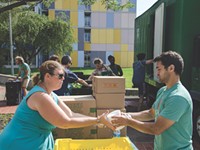[
{
"name": "500x250 Ad",
"insertPoint": "5",
"component": "15667920",
"parentWrapperClass": "",
"requiredCountToDisplay": "1"
}
]
When Marissa Adams, a University of Rochester alumna, is asked to talk about her major, she's hesitant to answer. Adams graduated in 2014 with a Bachelor of Science in physics and a Bachelor of Arts in mathematics, and will return to UR as a graduate student this fall.
"I never end up saying what my major is until someone asks," Adams says. "You always get the most horrible, or I guess, surprised responses. I've heard, 'Oh, you're too pretty to do physics.' Or 'Well, what are you going to do with that?' The standard thing is people are intimidated, that people see you as unable to connect to, or don't see you as a person, or beneath you intellectually."
Adams reflects a common sentiment faced by women in science, technology, engineering, and mathematics (STEM) fields. That is, preconceived notions of what sort of people are involved in the field, alongside the stigmas found in a male-dominated area.
The numbers continue to show a gender dominance in STEM fields. According to a US Census report entitled "Disparities in STEM Employment by Sex, Race, and Hispanic Origin," 1 in 5 female STEM graduates are out of the work force, compared to 1 in 10 males. Furthermore, 31 percent of the male population is employed in a STEM occupation, compared to 15 percent of the female population.
Perhaps most poignantly, while female occupations in mathematics and scientific fields have experienced a continuous growth since 1970, computer science, the field which makes up 80 percent of all STEM employment, has experienced a decline in female employment since 1990, from 35 percent of the work force to 26 percent. And engineering accounts for the largest disparity of job diversity, with 87 percent of the total workforce being male.
According to the census, 41 percent of all life and physical scientists are female. While this may seem evident of greater equality in these fields, recent trends in local college enrollment suggest this is may be a fleeting statistic. For example, as reported in RIT's annual study on diversity, female undergraduate enrollment in the College of Science has dropped more than 10 percent between 2010 and 2014, from 51.7 percent to 40.4 percent. Graduate enrollment has remained relatively stable, total enrollment for females in the College of Science have dropped from 49.3 percent to 39.4 percent. A similar trend can be found in the College of Applied Sciences, with a drop from 28.8 percent to 21.6 percent total enrollment.
Even in fields where the numbers have risen, the gender gap continues to be massive. In the Kate Gleason College of Engineering, named for a prominent female engineer, enrollment has risen, yet still peaks at only 22 percent of total enrollment.
On June 9, 2015, biochemist Richard Timothy Hunt gave a speech at the World Conference of Science Journalists in Seoul, Korea. Speaking to a room consisting mostly of female journalists and scientists, Hunt remarked that that women in the lab were prone to falling in love with their male coworkers and crying when receiving criticism, all before suggesting that men and women should have separate laboratories.
The backlash from Hunt's remarks was swift and pointed. A social media campaign, under the "#distractinglysexy" hashtag, started by feminist writer Rhiannon Lucy Cosslett, sent Hunt under intense scrutiny from the public. As the controversy began to boil over, Hunt spoke out to claim the statements were simple, albeit ill-advised, jokes. Nonetheless, the pressure on Hunt would lead to his forced resignation from University College London as well as the European Research Council.
While Hunt maintains that these remarks were jokes, the power of these words from any scientist — let alone an esteemed Nobel Prize winner — can reinforce a negative attitude often battled by the female STEM community.
As Melanie Heywood, a first year industrial design major at RIT, explained, this condescending attitude can be, and often is, fueled by gender.
"A few years ago, I was in a career mentoring program for young adults who were going into architecture, construction, and engineering," Heywood says. "And I felt that a lot of the time — being one of maybe two or three girls in the program — that my ideas weren't taken seriously. That if I said something, some guy would pat me on the back and say, 'Oh, that's a good idea, sweetheart.'"
This form of treatment is referred to as a microaggression, specifically microinvalidation, the act of dismissing someone's intellectual input on the grounds of a perceived short-coming, likely due to an ingrained prejudice. In this case, women are seen as weaker or less able to create truly valuable input.
"Even though you hear everywhere now a days that women can do anything, women can do whatever they want, there's still a lot of pressure, socially, not to go into 'man jobs,'" Heywood says. "When I'm working with a group of men I don't know, there's an assumption that I might not be able to do as much. It's variable, but especially with men I don't know or older men, they can be a little unwilling to allow me to participate."
Adams, who has experienced similar incidents in her own studies, has a theory as to why women tend to be dismissed in STEM fields in this manner far more often than men.
"From the get go, when you're born, your sex is there," Adams says. "People start planning this shit from the very beginning. 'Am I gonna have a boy, or am I gonna have a girl?' You are conditioned by your sex from the moment you are born; even before you are born. The thing that can be clearly observed is that, for young girls, the positive feedback they get when they are younger are things that are innate about them. Things like what they're wearing, how their hair is, how they look, 'don't let Sally eat that piece of cake, you don't want her to get too fat,' or 'you look adorable in that dress'. Whereas, young boys are praised for things that they've done, or things they've created."
Dana Cody, a third year physics major at SUNY Geneseo, explained some of her observations in her studies.
"In many textbooks, say there's homework problem about a scientist measuring something," Cody says, "and in most cases the scientist is a male. Which, I mean, doesn't bother me greatly, because it's just a homework problem, and physics is a pretty male dominated field. But it can come off as implying that only men can be scientists, which isn't true."
An increase in female workers in STEM fields began in 1970, coinciding with the rise of second-wave feminism, which focused intensely on workplace inequality and disparity in employment. In the early 1990's, when female enrollment in computer science fields began to drop, third-wave feminism had gained a foothold with the goal of shattering stereotypes of gender roles. Yet, today, the statistics in college enrollment and the workforce seem to indicate the problem has stagnated.
"You hear these famous names: Einstein, Schrodinger, Feinman, and so on," Adams says. "All of these names are all white males, with some genius idea floating around them. These role models can be harder to relate to for a female; where as a white male, who sees Einstein with his hair and pipe, as a white male face of physics, has a role model to look up to. It can start to make you question whether you can do this."
While the modern fourth-wave of feminism is in full swing, it can be argued that it is a continuation of second-wave feminism. It fights the same issues, the same sexism, the same preconceived notions, and the same gender roles that were battled in the 1960's. Though female undergraduate students make up 56 percent of total students nationwide, the STEM fields still remain disproportionate, and in some cases remain relatively unchanged.
With these aforementioned trends, and the testimony of students who continue to feel some sort of bias, the question is begged of what there is to be done.
"I think that when you talk to any individual, we can all say that someone in our group has more opportunity or advantage than we do," says Cha Ron Sattler-Leblanc, associate director for RIT's Center for Women and Gender. "But when we start to take that apart and say, 'Well, I identify as this group, do I have more privilege than another group?" that becomes more entwined and difficult to talk about."
Sattler-Leblanc says one of the major factors in unhealthy environments is the simple presence of a bias and denial.
"As much as we know that some of this exists, we never like to think that it's us," Sattler-Leblanc says. "'That bias stuff? That's not me.' But even when we talk about bias, everyone has bias; we see bias in everything we see today, whether we talk about how we do our jobs, to our roles, to how we make decisions on who we vote for. Bias is something that all of us have, but especially when we have an environment where we're supposed to be tolerant and correct, it can be much more difficult for us to challenge each other and ask, 'Are you checking your bias?'"
With students from diverse backgrounds, Sattler-Leblanc argues that the key tool to easing some of these problems is simple education.
"Progress can be made, but it starts with education," Sattler-Leblanc said. "It's not going to be easy. We have to be willing to have these difficult conversations, and I think colleges and universities are the perfect places to have those conversations."









